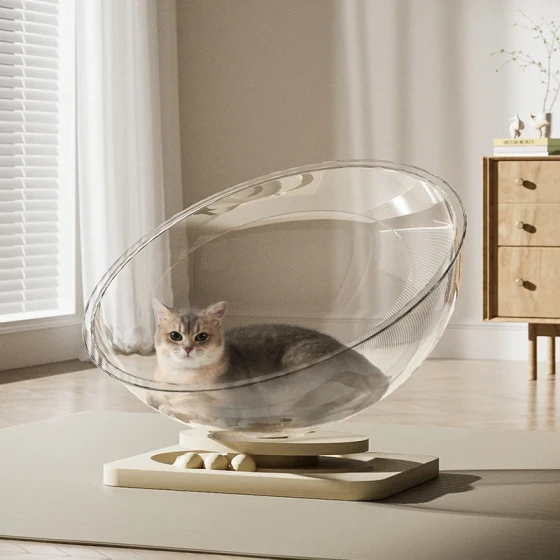Cat Bites Hardly_Attack Owner: 6 Major Reasons Why Cats Bite Hard and How to Respond
Cats often appear soft and cute in our minds, but sometimes their little teeth and paws can cause us some “trouble,” especially when a cat bites hard. Not only can it startle people, but it may also bring health risks. Don’t worry, this usually isn’t because the cat intends to hurt you but rather because it is conveying some messages through biting. By understanding these signals, we can better get along with our feline overlords and avoid unnecessary “bloodshed.” In general, cats may bite for various reasons, including pain, fear, overstimulation, improper play, etc. The key is to read the cat’s body language and respond and prevent properly.

Now, let’s talk in detail about why cats bite hard and how we “cat servants” should respond.
6 Common Reasons Why Cats Bite Hard
Cat behavior is very complex, and they don’t attack without reason. Biting is often their way to communicate, express emotions, or cope with the environment. Here are some of the most common reasons:
-
Pain or Discomfort: This is one of the primary reasons to consider. If a cat suddenly bites when touched in a certain spot, it’s likely feeling pain. For example, arthritis, toothache, injury, or even unseen internal illnesses may make the cat sensitive and irritable. They bite to tell you, “I’m hurting, don’t touch me!”
-
Fear or Anxiety: When cats feel scared or threatened, they may choose to attack as a defense. This could be because they are in an unfamiliar environment, have encountered unfamiliar people or animals, or have had unpleasant experiences. When they feel trapped with no way out, they may raise their fur, hiss, growl, and if the threat persists, they might resort to biting to protect themselves.
-
Overstimulation / Petting-Induced Aggression: Sometimes, while petting a cat, we might not notice their “signals.” Cats’ skin and nerves are very sensitive; prolonged or repeated petting in the same area can cause them to feel “overloaded,” much like us wanting to pull away when being tickled too long. When a cat’s tail starts flicking quickly, ears go back, or body stiffens, it’s saying “Enough!” If you don’t stop, it may end the interaction by biting. This type of aggression often happens suddenly.
-
Play Aggression: Kittens learn hunting skills through play, including pouncing, biting, and scratching. If a kitten hasn’t learned to play gently (e.g., using toys instead of hands) or becomes overexcited during play, it might use too much force and accidentally hurt the owner. This attack usually targets rapidly moving fingers or toes; the cat might arch its back, dilate pupils, and look excited.
-
Territorial Behavior: Cats have strong territorial awareness. If someone or another animal invades what it considers its space (such as its bed or near its food bowl), it might become aggressive and try to drive the “intruder” away through biting.
-
Redirected Aggression: This is a quite tricky situation. A cat may see another cat or prey outside the window, become very excited or frustrated but cannot reach the target. If you happen to be nearby at that moment, it might redirect that aroused aggression onto you, involuntarily making you the “scapegoat.”
How to Respond After Being Bitten by a Cat?
When a cat suddenly bites you, your immediate reaction might be to scream or quickly pull your hand back. However, this can backfire.
- Stay calm, don’t scream or pull your hand back: Screaming may make the cat more tense or excited. Quickly pulling back can worsen the bite because a cat’s teeth have barbs that might tear the skin. Try to stay still and say “No” or give a stop command in a calm voice.
- Slowly move away: If the cat hasn’t bitten deeply, try distracting it with a toy or other item and slowly withdraw your body part.
- If bitten deeply, don’t yank hard: If a cat bites stubbornly, don’t forcibly pull it away. You can try offering a tiny bit of food or a treat near its mouth to lure it to release. Or gently push toward the direction of its bite; sometimes this discomfort causes them to let go.
- Safely retreat: Once the cat releases, move away safely to another room and give it some alone time to calm down. Do not punish it; physical punishment will only make the cat more afraid of you and may worsen aggressive behavior.
How to Prevent Cats from Biting?
Prevention is better than cure. Understanding a cat’s body language is key.
- Learn the cat’s body language: Observe the cat’s ears (forward means relaxed/curious, backward or sideways means tense, scared, or angry), tail (slow swinging means thinking or relaxed, fast flicking means irritation or excitement), pupils (dilated may mean fear, excitement, or aggression), body posture (arched back, raised fur means defensive or preparing to attack), etc. Stop immediately once it sends a “stop” signal.
- Provide a rich environment: Ensure the cat has plenty of toys (cat teasers, realistic prey toys, etc.), scratching posts, and cat trees to perform normal hunting, playing, and climbing behaviors to expend energy and reduce boredom- or stress-induced aggression.
- Play properly: Use teaser toys to interact with your cat instead of hands or feet. Mimic prey movements to allow the cat to chase and pounce on toys, satisfying their hunting instincts. At the end of play, offer a treat to simulate the process of catching and eating prey.
- Avoid overstimulation: Find the areas and durations the cat likes to be petted. Usually, cats enjoy being touched on the head, chin, and neck. The belly or base of the tail is a no-go area for many cats. Watch the cat’s reaction during petting and stop immediately if it shows signs of irritation.
- Gradual socialization: If a cat feels fearful of strangers or new environments, patiently guide it to adapt step by step; don’t force confrontation with fearful stimuli.
- Regular health checks: Take your cat to the vet regularly to rule out behavior problems caused by pain or illness.
Risks and Treatment of Cat Bites
Cat bites, especially deep ones, carry a risk of infection. Cats’ mouths harbor many bacteria. According to some animal health organizations, cat bites are more prone to infection than dog bites because their sharp teeth can deliver bacteria deep into tissues.
- Immediate wound care: Wash the wound thoroughly with soap and water for at least 5 minutes.
- Disinfection: Use iodine solution or medical alcohol to disinfect the wound.
- Observation: Watch for signs of infection such as redness, increased pain, fever, or pus.
- Seek medical attention promptly: If the wound is deep, bleeding excessively, or showing infection signs, go to the hospital immediately. Doctors may recommend a tetanus shot or antibiotics.
Frequently Asked Questions (FAQ)
- Q: What does a cat’s gentle bite mean?
A: A gentle bite (not forceful, sometimes barely touching the skin) can be an extension of grooming and may indicate affection. But during play, gentle biting can also be a warning or signal that the cat is getting excited or uncomfortable. - Q: My cat suddenly became aggressive, what should I do?
A: First, consider health issues and take your cat to a vet for a full examination. After excluding health factors, consider environmental changes, stress, or behavioral issues, and consult a professional animal behaviorist if needed. - Q: Is punishing a cat for biting effective?
A: Physical or other punishments usually do more harm than good, making the cat more afraid of you and damaging your relationship. It may even worsen aggression. The correct approach is to understand the reasons and actively guide and prevent.
In summary, cats biting hard is usually the result of multiple factors and rarely out of malice. As cat lovers, we need to be patient to observe and understand our feline friends, read their “cat language,” and manage and guide them scientifically to build a more harmonious and beautiful relationship. Remember, if a cat’s aggressive behavior is severe or hard to control, seeking help from professional veterinarians or animal behavior experts is very necessary.





